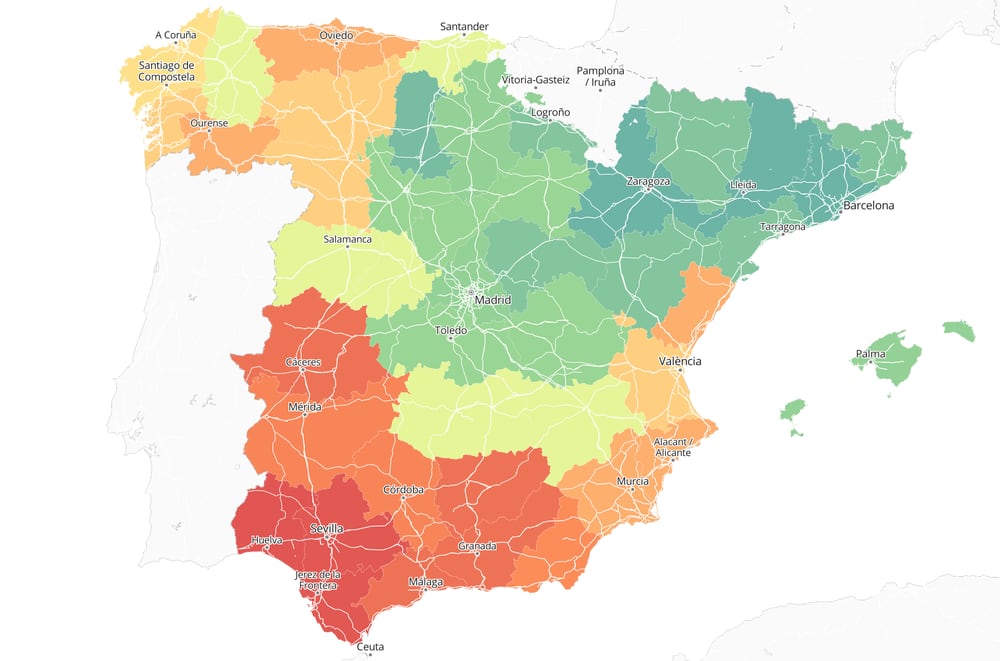The income of a home influences the fate of your children 20 years later. This is one of the conclusions of the Atlas of Opportunities, of the Felipe González y Cotec Foundation, whose detailed results have been advanced by EL PAÍS. The study crosses the income of families in 1998 with that of their children in 2016, when they had grown to be between 26 and 32 years old.
But these data show that there is another key: the future income level of the children of a household also depends on the geography, the city, the municipality or the neighborhood where they grow up.
The map indicates that being born in some regions seems to have given an advantage. In Catalonia, 21% of the children of poor families have managed to be among the richest in Spain at their age, while in Extremadura only 8% have managed to rise that much. Below, we show places that stand out because young people have done especially well or very badly.
❌ | ✅ Different opportunities from neighborhood to neighborhood
Sometimes it is enough to cross a street to find contrasts on the map. In Valencia, children from middle-income households who grew up between Colón and Marqués del Turia today have incomes of the 58th centile, above the Spanish average, while their neighbors north of the street Colón is well below (the centiles are used to order the income of households and children. For example, the 1% of households with less income belong to the 1st centile; those that are in the average, to 50; and 1% with more income, to the 100 centile, the richest).
In Madrid, there are two neighborhoods that touch each other and where middle-income children have had very different performances: those who grew up around Chamartín now earn about 7,000 euros more on average than their northern neighbors, Chamberí, or 5,000 more than those from Tetouan, although they live a few blocks away.
✅ The success of metropolitan areas from Madrid and Barcelona
In the 1970s and 1980s, many municipalities on the outskirts of Madrid and Barcelona became large cities, forming two metropolitan areas. They multiplied their population with people, coming from other provinces of Spain, who were looking for opportunities for themselves and their families. And it is possible that they have succeeded: the children of low-income households who grew up in those cities now have incomes above the Spanish average.
The effect is very clear around Barcelona: L’Hospitalet, Sabadell, Badalona and Terrassa are four of the five cities in Spain where the income of the children of households with low incomes (below the average) has increased the most. The third position is for Coslada and in the top 16 nationals are also Getafe, Fuenlabrada, Leganés, Alcalá de Henares, Alcorcón and Torrejón de Ardoz, all from the surroundings of Madrid.
❌ Cities without elevator in the sure and Canary Islands
The provincial capitals of Andalusia, Extremadura and the Canary Islands stand out for the worse: there the children of poor households earn less than their parents. In Cádiz, Seville, Cáceres or Granada, they have grown to be at the 35th centile on average, while those same households exceed the 40th centile in Spain. In some of these cities, the children of relatively wealthy households did not fare too well. Children with parents from top 20 have fallen below the 50th centile – the Spanish average – in Huelva, Almería, Cádiz or Santa Cruz de Tenerife.
When judging these results, migrations are key. Is it so frequent that a person from Cádiz or Fuengirola moves to Madrid than someone from Palencia, Guadalajara or Ávila? Our data indicate that it is not for the young people in their 30s that we are analyzing. People who move to other provinces generally increase their incomes, so that young people from areas where there are fewer who leave, will partly have lower incomes. It does not seem by chance, therefore, that among these cities without a lift we find many in Andalusia, the Canary Islands, Murcia or Alicante, because they are places where few young people left.
❌ A problem for kids in the center of big cities?
In Madrid and Barcelona, where poor households did well, something that happens in their centers is striking: their sons have fared much worse there than their daughters. It is something appreciable in several postal codes around Sol (in Madrid) or Las Ramblas (in Barcelona). South of Gran Vía, male children from poor families now earn about 5,000 euros less than those from similar families in Fuenlabrada. Daughters earn the same in both places. In Barcelona, the gap is even greater: male children from poor families in the Raval now earn about 6,000 euros less than those of families with the same income in L’Hospitalet de Llobregat, while women only earn 2,000 euros less in one place and other.
The graph below quantifies this phenomenon. Compare those zip codes in the center of Madrid and Barcelona with children from similar homes in Móstoles, Fuenlabrada, Mataró and L’Hospitalet. The daughters of the most humble homes have fared more or less the same in all three places, but with the boys there is an abysmal difference.
❌ Low rents in beach destinations
If one travels the coast of the map, from Girona to Huelva, the most tourist destinations are often highlighted because they appear in red. In these municipalities, the children of poor or middle-income households have grown up to have relatively low incomes. It is something that we can see in Sitges (Barcelona), Oropesa del Mar (Castellón), Cullera (Valencia), Torrevieja (Alicante), Los Alcázares (Murcia), Mojácar (Almería), Almuñecar (Granada), Chipiona (Cádiz) or Punta Umbria (Huelva).
✅ Martos, Almussafes, Alhama and Vandellòs?
On the map there are also some municipalities where children prosper over their parents in a large proportion. Sometimes it is noise – there are few children and they have done well by chance – but other times we find patterns.
One of those places is Martos, in Jaén, an industrial center. There the children of households with lower incomes have finished above the national average (56th centile), while the rest of the province is below (39th centile). Something similar is observed in Benifaió and Almussafes, south of Valencia, where the Ford plant and many suppliers are located.
Other islands of wealth are mining areas of Asturias, in the surroundings of Cangas del Narcea, Ibias or Dagañas, where the current income of children of poor families is up to 8,000 euros higher than those of their neighbors in Villablino or Cabrillanes. In Murcia, the municipalities of Torre-Pacheco, Fuente Álamo and Alhama de Murcia are highlighted on the map. The first and second have a powerful agricultural industry and in the third, the livestock sector and the ElPozo factory stand out.
The young people who grew up in the municipalities of Ascó, Almaraz, Vandellòs and Trillo have also been especially enriched. All four have a nuclear power plant.
–


